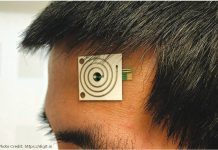
It is already known in scientific environments that each device emits besides Wi-Fi signals, some terahertz waves. They are electromagnetic waves with a high frequency in-between microwaves and infrared light, being called “Terahertz rays”. Very interesting to notice that any object that register a temperature, even our bodies are producing Terahertz rays.
Terahertz waves are everywhere in our daily lives, and use of their concentrated power could serve as an alternative energy source. Now, please try to imagine a smartphone charged by use of Terahertz waves, because as you know they are simply wasted because of no practical solution in use.
MIT researches bring solutions
Physicists at MIT bring a model of device that they lead capable of converting ambient terahertz waves into electrical current, which will be able to power many home appliances.
Their prototype uses the advantage of the quantum mechanical behavior of graphene, or the atomic behavior of graphene from carbon material.
They found that by combining graphene with another material, in this case boron nitride, the electrons change their direction. Thus in this combination the terahertz waves determine the transfer of electrons in one direction as a direct current.
The researchers published their results in the journal Science Advances, being concerned about the physical realization of the final device.
The MIT research project team
The main author of the study is Mr. Hiroki Isobe, who is doing postdoctoral studies at MIT’s Materials Research Laboratory. He believes that the existence of these electromagnetic terahertz waves around us, and the conversion of these energies for daily activities, would help us to cope with the energetic challenges that humanity is facing these days.
The co-authors of this study are Liang Fu, the Lawrence C. and Sarah W. Biedenharn, Associate Professor of Physics at MIT and Su-yang Xu, a former MIT post PhD student, who is now an assistant professor of chemistry at Harvard University.
Rearranging the symmetry of graphene
Tesla tried to send energy at distance, now over a decade scientists were on searching how to convert electromagnetic waves of energy from their oscillating current into direct current using rectifiers.
Usually rectifiers are designed to convert waves with low frequency emission, for example radio waves, using in their electrical circuits diodes, and filtrating a DC current, but with no results at the terahertz range.
There are few laboratory technologies that are able to convert terahertz waves into DC current but only at ultracold temperatures — something difficult to implement in usual applications. Instead of trying to transform the terahertz waves directly into DC current using diodes, Isobe tried to adopt a change of perspective, wondering if he could somehow at the level of quantum mechanics determine the electrons of a material to flow in a desired direction, reaching thus transforms terahertz waves this way into direct current.
The image of such a material must be ideal, without any impurities, so that the electrons flow easily without getting lost in its irregularities and they chose Graphene, to be the starting material.
In order to direct the flow of electrons through graphene, the researchers had to affect the symmetry of the material, to apply a “inversion” process. For this, Isobe looked for alternatives to induce an asymmetrical flow of electrons in response to the input energy.
Using the experience of his predecessors, he found in the literature that others placed graphene over a layer of boron nitride, as a kind of honeycomb network with two atoms, that of boron and nitrogen. They have thus achieved an imbalance of the opposing forces, between the graphene electrons. The overall effect called by physicists as “skew scattering,” in which clouds of electrons drive their motion in one direction.
As expected, Isobe developed a systematic theoretical study of all the ways in which graphene electrons could scatter in this combination with boron nitride layer, and more of that, how this scattering of electrons could affect the input of electromagnetic waves, especially those at the terahertz level.
If the graphene structure contains too many impurities, it would act as barriers, in the path of electron clouds, causing them to spread rather than flow in one direction.
In addition, they realized that if the terahertz wave energy is stronger, the resulting DC will be stronger. Concluding from here that any device that converts terahertz should concentrate them before engaging them in conversion.
The same one direction
With all these ideas in mind, the researchers devised a model of a device to rectify, terahertz waves. It is made up of a small square of graphene, which is placed on a boron nitride layer, from which is attached an antenna that collects terahertz waves, to get a stronger signal and then to convert it to DC current.
They started to patent this new device called now,“high-frequency rectification”, and along MIT experimental physicists they expect to have a device which could work at room temperature, in order to be used in many portable applications.
Besides the immediate utility of this patent, to provide the possibility of charging the battery of your laptop or smartphone with the help of wi-fi signals, the most interesting thing would be in the future, that with the help of these terahertz waves, the devices implanted in the bodies of patients could be charged without the need for patient to be operated for battery replacement.



